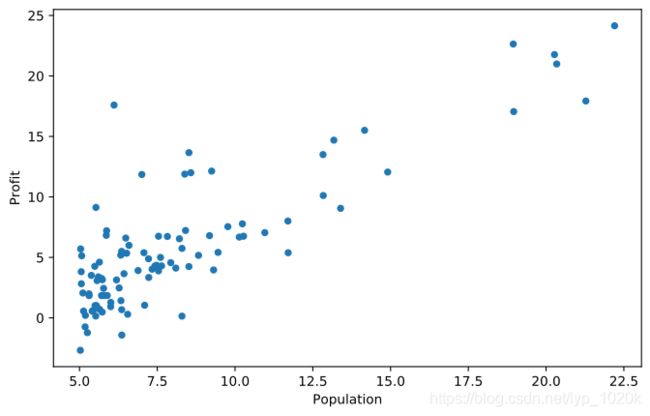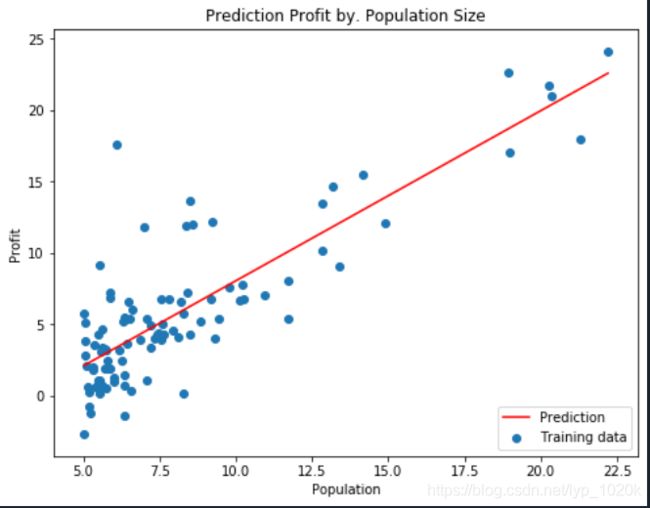吴恩达机器学习作业一python实现
单变量线性回归
参考了黄海广的github:https://github.com/fengdu78/Coursera-ML-AndrewNg-Notes
数据处理
读入数据
path = 'ex1data1.txt'
data = pd.read_csv(path, names=['Population', 'Profit'])可查看数据的一些统计量
图:数据的一些统计量
展示数据
data.plot(kind='scatter', x='Population', y='Profit', figsize=(12,8))
plt.show()图:原数据的散点图
梯度下降
代价函数
# 计算代价函数J(θ)
def cost_function(X, y, theta):
diff = X.dot(theta.T) - y
return sum(np.power(diff, 2))/(2*m)梯度下降法
对θ0和θ1求偏导
# 求偏导
def gradient_function(X, y, theta):
diff = X.dot(theta.T) - y
return diff.dot(X)/m梯度下降
def gradient_descent(X, y, alpha):
theta = np.array((m,1))
gradient = gradient_function(X, y, theta)
while not all (abs(gradient) <= 1e-5):
theta = theta - alpha * gradient
gradient = gradient_function(X, y, theta)
return theta
找到的最佳的θ
进行可视化
population = np.linspace(data.Population.min(), data.Population.max(), 100) # 横坐标
profit = optimal_theta[0] + (optimal_theta[1] * population) # 纵坐标
fig, ax = plt.subplots(figsize=(8, 6))
ax.plot(population, profit, 'r', label='Prediction')
ax.scatter(data['Population'], data['Profit'], label='Training data')
ax.legend(loc=4) # 4表示标签在右下角
ax.set_xlabel('Population')
ax.set_ylabel('Profit')
ax.set_title('Prediction Profit by. Population Size')
plt.show()源码:
import numpy as np
import pandas as pd
import matplotlib.pyplot as plt
path = 'ex1data1.txt'
data = pd.read_csv(path, names=['Population', 'Profit'])
m = len(data)
data.plot(kind='scatter', x='Population', y='Profit', figsize=(12,8))
# 计算代价函数J(θ)
def cost_function(X, y, theta):
diff = X.dot(theta.T) - y
return sum(np.power(diff, 2))/(2*m)
# 求偏导
def gradient_function(X, y, theta):
diff = X.dot(theta.T) - y
return diff.dot(X)/m
# 梯度下降
def gradient_descent(X, y, alpha):
theta = np.array((m,1))
gradient = gradient_function(X, y, theta)
while not all (abs(gradient) <= 1e-5):
theta = theta - alpha * gradient
gradient = gradient_function(X, y, theta)
return theta
X = data['Population']
y = data['Profit']
X = np.vstack((pd.Series(np.ones(m)), X)).T
alpha = 0.01
optimal_theta = gradient_descent(X, y, alpha)
print('optimal_theta:', optimal_theta)
population = np.linspace(data.Population.min(), data.Population.max(), 100) # 横坐标
profit = optimal_theta[0] + (optimal_theta[1] * population) # 纵坐标
fig, ax = plt.subplots(figsize=(8, 6))
ax.plot(population, profit, 'r', label='Prediction')
ax.scatter(data['Population'], data['Profit'], label='Training data')
ax.legend(loc=4) # 4表示标签在右下角
ax.set_xlabel('Population')
ax.set_ylabel('Profit')
ax.set_title('Prediction Profit by. Population Size')
plt.show()本人刚开始学,才疏学浅





